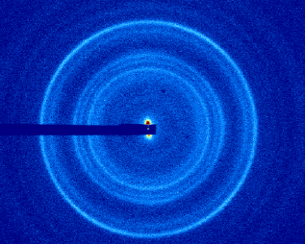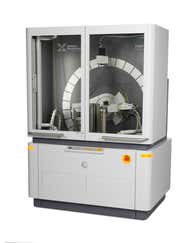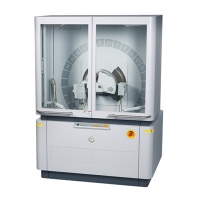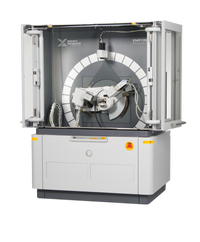Small-angle X-ray scattering (SAXS)
Small angle X-ray scattering for nanomaterial analysis applications

Small angle X-ray scattering for nanomaterial analysis applications

Small-angle X-ray scattering (SAXS) is an analytical technique that measures the intensities of X-rays scattered by a sample as a function of the scattering angle. Measurements are made at very small angles, typically in the range of 0.1 degrees to 5 degrees.
From Bragg's law it is understood that with decreasing scattering angle, increasingly larger structural features are being probed. A SAXS signal is observed whenever a material contains structural features on the length scale of nanometers, typically in the range of 1-100 nm. On the other hand, wide-angle X-ray scattering (WAXS), also known as wide-angle X-ray diffraction (WAXD), probes for structures in the material on a much smaller length scale, that of interatomic distances. Small-angle X-ray scattering and wide-angle X-ray scattering (SAXS and WAXS) are complementary techniques.
The experimental setup for SAXS measurements uses a transmission geometry. X-ray optics that create a very narrow, yet highly intense incident X-ray beam are essential. This is because the comparatively weak scattering signal from the sample has to be measured in the immediate vicinity of the direct beam. It is also essential to use a detector that has a high linearity, a high dynamic range and negligible intrinsic noise. A high spatial resolution of the detector is beneficial for high-end SAXS instrumentation because it allows a good low-angle resolution to be achieved even with a compact experimental setup.
SAXS method is one of the most versatile techniques for the structural characterization of nanomaterials. The samples may be solid objects, powders, gels, or liquid dispersions, and they may be amorphous, crystalline, or semi-crystalline.
Measurements require only minimal sample preparation and can often be done in situ. Being an ensemble technique, SAXS probes for structural features averaged over a large sample volume.
Typical samples that can be studied by Small-angle X-ray scattering include:
From the evaluation of the measured scattering profiles a wide range of information about the structure and properties of the materials can be obtained, such as:
Control of these parameters is essential because they are correlated with the chemical and physical properties of the nanomaterials. They also determine the performance of the material in the application. SAXS is a tool that is useful both in R&D for the development of new materials and also in quality control.

Multipurpose X-ray diffractometers for your analytical needs
The Empyrean Nano edition is a dedicated X-ray scattering platform which enables a variety of X-ray scattering techniques that can be applied for the structural characterization of (nano)materials on multiple length scales.
The Empyrean X-ray diffraction platforms can be quickly configured for SAXS measurements with a compact setup. There is a wide choice of optical components, sample stages and detectors. The configuration may be adapted to specific sample and performance requirements.
ScatterX78 is a PreFIX attachment to the Empyrean, allowing for high-performance SAXS/WAXS measurements. The beam path is evacuated to achieve a good sensitivity even for weakly scattering samples.
Our hybrid PIXcel detectors excel in this application thanks to their very low intrinsic noise level, high dynamic range, high count rate linearity and small pixel sizes.
Our EasySAXS software contains a complete toolbox for SAXS data analysis. It allows for data reduction, model-independent data analysis, particle size distribution determination, as well as fitting and simulations with a wide variety of models.
The software also offers options for automation and reporting. It contains advanced and proven algorithms that are conveniently accessible via a graphical user interface.
EasySAXS has been designed for ultimate ease of use and is suitable for beginners and advanced users alike.

Empyrean Nano EditionVersatile X-ray scattering platform |

EmpyreanThe intelligent diffractometer |
|
|---|---|---|
| Technology | ||
| X-ray Diffraction (XRD) | ||